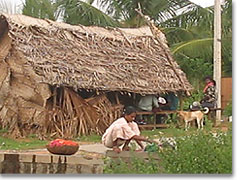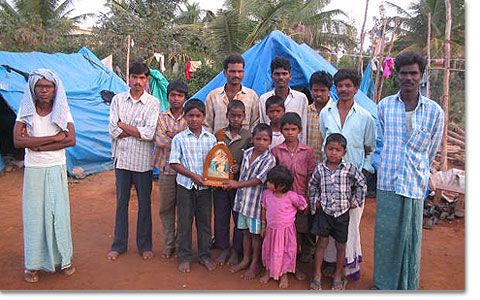 |
 |
Se repite la visita de Maria con su prima Isabel
Mary’s visit to Elizabeth repeated
Der Besuch von Maria bei Elisabeth wiederholt sich
|
|
 |
|
La Gran Misionera conoce al pobreza
The Great Missionary knows poverty
Die Große Missionarin kennt die Armut
|
|
 |
|
Descubrir Maria en la pobreza
Discovering Mary in this poverty
Maria entdecken in dieser Armut
Fotos: Aymerich © 2006
|
|
|
|
INDIA, Rosa and Edu Aymerich. How can one transmit what one experiences
and dreams about in this land! The India of "The Wedding of Monzon" to
the India of Dominque La Pierre’s "City of Joy", there are several ways
of being, of cultures and nuances that are difficult to imagine, with
their kind faces and dark sides.
It is not always possible to discover what daily life is like in a great
part of the world; one part of what is known is through television, or
from stories that missionaries who come and go tell, but these are not
real until one lives it. Since we have been here there has not been a
day that we do not receive a kind look from an unknown person in the street,
or the laugh of a curious child who cannot take his eyes away from possibly
the first white person he has seen in his life. It is true that when one
arrives in India one collides with poverty, and in some cases, with the
most absolute misery.
The two faces of poverty
The "joyful poverty of Dominiqu Lapierre", has the face of the humble
people, who do not complicate their life and for whom our needs are dreams
of science fiction. The generous face of he who has nothing but gives
it all, be it a piece of food in a banana leaf or his own wooden bed without
a mattress so that you do not have to sleep on the floor. How everything
changes when one experiences these things! To meet people who are poor
and are happy. It is healthy happiness, a joy of one who does not know
about the conveniences of our world and only struggle for a simple life,
that of each day, without any illusion other than to see their children
grow or to have a chat with his neighbor before he goes to bed.
This is the kind face of poverty that from afar seems somewhat romantic.
How beautiful it is to dream of helping and living among the most humble,
the idea of being austere to the extreme, the fantasy of the missionary
adventurer! However, at the time that one has to live with it, it is not
as friendly as it was fancied, above all, when you discover its bitter
part. The dark side of poverty "smells". It smells of contamination and
of street dogs, of stagnant water and unwashed children. It smells of
trash that is thrown on the pavement, and of cows, dogs, and rats that
eat it and live in it. It has an acrid smell of thousands of men who urinate
anywhere, and the gray color of excrement of those for whom the streets
and the trees are their only bathroom.
What can Schoenstatt give India?
Many times we commit the error of thinking that the problem of poverty
is only a question of money! We easily forget that the most important
thing is not in what I have, rather, in how to live with the little that
I have! In this sense, how does Schoenstatt respond to the challenge of
making poverty something more beautiful and worthy?
The first thing, and the most valuable treasure that Schoenstatt can
give India is the Shrine. In this place of grace, the Blessed Mother takes
us in as we are, she makes us feel more and more that we are hers, she
educates us, and she elevates our natural simple selves to children of
God. Furthermore, through the Movement, Schoenstatt has a great mission
of educating man in the noblest Christian values, and of giving Mary as
a Mother and model.
Social Projects
Beyond this, many social projects have been undertaken. The school and
childcare center of Bangalore, with more than two thousand students, and
with dues that make it accessible to the most humble, there are several
small schools for the children of the streets. Around the Shrine, there
are also scheduled activities, for example, a festive dinner to celebrate
Christmas for the poorest people. Furthermore, Schoenstatt is in charge
of the small center for the handicapped.
On the other hand, an orphanage is also being built that will be named
"Children Village". This city of children hopes to be more than just a
shelter, it hopes to a true home for all those who seek shelter in it.
More than a bed and a plate of food, the really important thing is for
these children to grow in an atmosphere where affection reigns, where
there is personal contact, where there is joy and above all where there
is love.
All these things that we want to keep in our heart so that we never forget
the real world in which the majority of men live. The world that we were
taught about and that we learned about when we were young has changed.
This experience will mark our lives forever, and it will help us realize
how fortunate we are, and that we can also live in a simpler manner and
to aspire for a life that is more austere and joyful.
Translation: Celina M Garza, Harlingen, TX, USA
|



